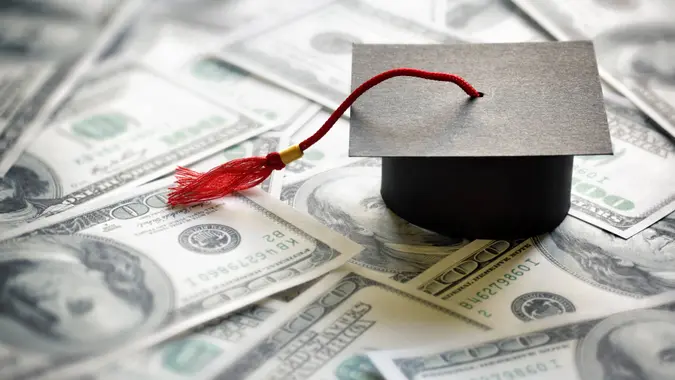How To Calculate APR on a Car Loan

Commitment to Our Readers
GOBankingRates' editorial team is committed to bringing you unbiased reviews and information. We use data-driven methodologies to evaluate financial products and services - our reviews and ratings are not influenced by advertisers. You can read more about our editorial guidelines and our products and services review methodology.

20 Years
Helping You Live Richer

Reviewed
by Experts

Trusted by
Millions of Readers
What Is APR?
The APR, or Annual Percentage Rate, of a loan is the amount of interest you’ll be charged in one year for that loan. The APR is determined by the interest rate for your car loan. It also includes fees and other borrowing costs.
Your car loan interest rate is expressed as a percentage — which is charged against the total loan amount. For example: if you buy a $20,000 car with an 8% interest rate, you’ll pay $1,600 in interest for the year.
However, the APR also includes fees and other borrowing costs and is usually higher than the initial interest rates. While the interest rate on your car loan might be 6.8%, for example, the total APR might be 6.99%.
Why You Should Know Your Car Loan’s APR
The APR on your car loan shows you how much additional money you’ll pay when purchasing a car if you finance it with a car loan. Here’s why: if you buy a car for $30,000 with a 10% APR, you’ll end up paying for the $30,000 loan balance through principal payments, but also additional interest payments. The principal payments are equal to 10% of the car’s value over a year; in this case, you’d pay $3,000 in interest during that first year.
Your APR will also determine your monthly payments on the car itself. This is because your monthly car loan payments include both principal and interest payments. If your APR is 10%, you’ll pay around 0.83% interest per month. This means on a $30,000 car loan, you’re paying around $249 in interest per month. If you get a lower 8% APR, you’re only paying around $198 per month in interest.
Factors Influencing APR on Car Loans
Your APR is determined by your:
- Credit score
- Loan amount
- Loan term length
- Down payment amount
- Income and debt balances.
In general, the higher your credit score, the lower your APR will be. In some cases, though, you can secure a lower APR by putting more money down on your loan or choosing a shorter loan term.
Another factor in determining your APR is buying a new vs. used vehicle. In general, new vehicles qualify for lower APRs — usually due to dealerships securing more profit from the purchase price of the car. Some new cars even have interest rates as low as 0% to incentivize new car buyers. Used cars may have a higher APR for lenders to make a profit due to lower margins on the purchase price.
How Does APR Work on a Car Loan?
When you calculate the interest rate on a car loan, it is simply a percentage of the total loan balance. The APR also includes the addition of fees and other borrowing costs associated with your car loan, which is averaged out over the life of the loan.
The APR is calculated by taking the interest rate of the loan and adding in loan origination fees and any other borrowing costs. For example, if you get a car loan with a 9% interest rate and there’s an $800 origination charge and $200 in other fees, then this could bump the APR up to 9.49% on your loan. The APR is the total rate you’ll pay for your car loan — inclusive of every charge for the loan.
Did You Know?
A higher down payment can reduce your APR! Putting more money down shows lenders you are a reliable borrower — and in return, they may offer a lower rate.
Step-by-Step Guide to Calculating APR on a Car Loan
Here’s how to calculate the APR on your car loan:
1. Gather Loan Details
Get the details of your loan. This includes the total principal loan amount, interest rate, loan term and any fees. You’ll need to use this information to determine your total APR.
2. Calculate Monthly Payment
Your loan usually comes with an assigned monthly payment, but you may need to calculate the cost yourself. Add fees to the total loan amount and divide this by the number of months in the loan term.
3. Determine the Total Cost of the Loan
You’ll also want to know the total loan costs. Multiply the monthly payment amount by the number of payments. For example, if your monthly payment is $480 and your loan term is 60 months, then the total cost of your loan is $28,800.
4. Calculate Total Interest Paid
Now that you know the total loan costs, you’ll want to subtract the vehicle purchase price from the total loan cost. This will help you see the exact amount of total interest paid over the life of the loan.
If your total loan cost is $28,800, but the purchase price is $22,000, this means your total interest paid on the loan is $6,400.
5. Compute APR
Now you can calculate the APR for your vehicle. Here’s the formula:
APR = (((Interest + Fees) / Loan amount) / Number of Days in Loan Term) x 365) x 100
In this example, it might look like this:
APR = (((6,400 + 1,000) / 22,000) / 1,826) x 365) x 100
The APR for this example is 6.72%
- Note: This is a simplified formula; actual APR calculations can be more complex.
Tools and Resources for Calculating APR
Though you might know now how to manually calculate your APR, there are some better tools available to help you calculate APR, with some free options as well.
Online APR Calculators
There are plenty of online APR calculators to give you insights into your car loan and APR amount. These tools will give you the most accurate calculations and more details about your loan rates and fees.
Consulting Lenders
You can usually get the APR on your car loan directly from your lender. Federal law requires that lenders disclose the APR for your loan before you sign the paperwork.
Tips to Secure a Lower APR
If you want a lower APR, the best way is to improve your credit score. When you have a higher score, lenders trust you more to repay your loan and will offer lower APRs as an incentive for you to borrow with them.
To improve your credit score, you’ll want to focus on important factors such as making on-time payments on your debts and other monthly payments, lowering your debt-to-income ratio by paying off debts and making sure you keep long-term debts that are in good standing open.
You may also be able to get a lower APR with a shorter loan term, or by putting more money down. Both of these things lower the lender’s risk of being repaid, so they may offer a lower interest rate in return.
And finally, it’s always a good idea to compare lenders and shop around for the best rates and lowest APRs. Check with your local credit union and compare rates with online lenders instead of just using dealer financing.
Common Mistakes
APR vs. Interest Rate
Don’t confuse APR with the interest rate of your loan. The interest rate is the amount charged on the principal balance of your loan — but the APR also includes fees and borrowing costs to give you the total picture of your overall loan rates.
Not Checking Lender Fees
Make sure to review all lender fees before signing up for a car loan. Origination charges and other fees can add up and increase your car loan APR. Compare multiple lenders to find the best rates.
FAQs on How To Calculate APR on a Car Loan
Here are the answers to some of the most frequently asked questions about calculating APR on a car loan.- What is a good APR for a car loan?
- As of March 2025, interest rates for car loans range from 6% to 10% APR, depending on your state. The lowest rates are just below 6% APR, but highly depend on the car you're buying, loan amount, down payment amount and loan term chosen.
- Can I negotiate the APR on my car loan?
- Yes, when buying a car, you can simply ask for a better APR, or ask "Is that the best APR available for this car?" You can also shop around to find better rates with a different lender.
- How does a co-signer affect my APR?
- Yes, if your lender allows co-signers on your car loan, this can help lower your APR if they have good credit. When someone co-signs your loan, you can use their credit score and income to help you qualify -- and potentially get better rates.
- Is APR different for new and used cars?
- In general, new cars offer lower APRs on car loans due to higher margins and manufacturer incentives. Used cars usually have higher APRs to make up for lower margins and no dealer or manufacturer incentives.
- Does refinancing affect my APR?
- When you refinance a car loan, it can lower your APR if you have a better credit score or if rates have dropped — but make sure to understand the total loan cost. Refinancing a car loan and extending your loan term can end up costing you more in the long run.
Our in-house research team and on-site financial experts work together to create content that’s accurate, impartial, and up to date. We fact-check every single statistic, quote and fact using trusted primary resources to make sure the information we provide is correct. You can learn more about GOBankingRates’ processes and standards in our editorial policy.
- Consumer Financial Protection Bureau "What is the difference between a loan interest rate and the APR?"
- Bank of America. "Auto Loan Rates."
- Consumer Financial Protection Bureau "Can I negotiate a car loan interest rate with the dealer?"
- Cornell Law School - Legal Information Institute. "APR."
 Written by
Written by  Edited by
Edited by 























